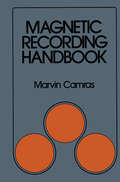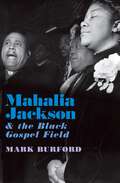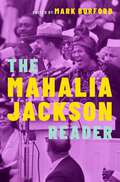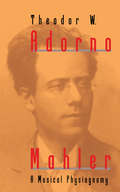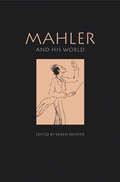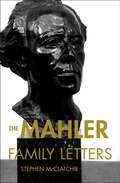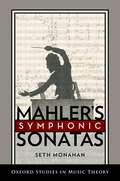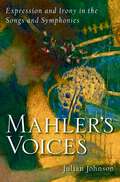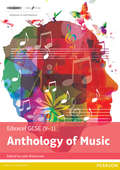- Table View
- List View
Mahalia Jackson and the Black Gospel Field
by Mark BurfordNearly a half century after her death in 1972, Mahalia Jackson remains the most esteemed figure in black gospel music history. Born in the backstreets of New Orleans in 1911, Jackson during the Great Depression joined the Great Migration to Chicago, where she became an highly regarded church singer and, by the mid-fifties, a coveted recording artist for Apollo and Columbia Records, lauded as the "World's Greatest Gospel Singer." This "Louisiana Cinderella" narrative of Jackson's career during the decade following World War II carried important meanings for African Americans, though it remains a story half told. Jackson was gospel's first multi-mediated artist, with a nationally broadcast radio program, a Chicago-based television show, and early recordings that introduced straight-out-of-the-church black gospel to American and European audiences while also tapping the vogue for religious pop in the early Cold War. In some ways, Jackson's successes made her an exceptional case, though she is perhaps best understood as part of broader developments in the black gospel field. Built upon foundations laid by pioneering Chicago organizers in the 1930s, black gospel singing, with Jackson as its most visible representative, began to circulate in novel ways as a form of popular culture in the 1940s and 1950s, its practitioners accruing prestige not only through devout integrity but also from their charismatic artistry, public recognition, and pop-cultural cachet. These years also saw shifting strategies in the black freedom struggle that gave new cultural-political significance to African American vernacular culture. The first book on Jackson in 25 years, Mahalia Jackson and the Black Gospel Field draws on a trove of previously unexamined archival sources that illuminate Jackson's childhood in New Orleans and her negotiation of parallel careers as a singing Baptist evangelist and a mass media entertainer, documenting the unfolding material and symbolic influence of Jackson and black gospel music in postwar American society.
Mahalia Jackson and the Black Gospel Field
by Mark BurfordNearly a half century after her death in 1972, Mahalia Jackson remains the most esteemed figure in black gospel music history. Born in the backstreets of New Orleans in 1911, Jackson during the Great Depression joined the Great Migration to Chicago, where she became an highly regarded church singer and, by the mid-fifties, a coveted recording artist for Apollo and Columbia Records, lauded as the "World's Greatest Gospel Singer." This "Louisiana Cinderella" narrative of Jackson's career during the decade following World War II carried important meanings for African Americans, though it remains a story half told. Jackson was gospel's first multi-mediated artist, with a nationally broadcast radio program, a Chicago-based television show, and early recordings that introduced straight-out-of-the-church black gospel to American and European audiences while also tapping the vogue for religious pop in the early Cold War. In some ways, Jackson's successes made her an exceptional case, though she is perhaps best understood as part of broader developments in the black gospel field. Built upon foundations laid by pioneering Chicago organizers in the 1930s, black gospel singing, with Jackson as its most visible representative, began to circulate in novel ways as a form of popular culture in the 1940s and 1950s, its practitioners accruing prestige not only through devout integrity but also from their charismatic artistry, public recognition, and pop-cultural cachet. These years also saw shifting strategies in the black freedom struggle that gave new cultural-political significance to African American vernacular culture. The first book on Jackson in 25 years, Mahalia Jackson and the Black Gospel Field draws on a trove of previously unexamined archival sources that illuminate Jackson's childhood in New Orleans and her negotiation of parallel careers as a singing Baptist evangelist and a mass media entertainer, documenting the unfolding material and symbolic influence of Jackson and black gospel music in postwar American society.
The Mahalia Jackson Reader (Readers on American Musicians Series)
by Mark BurfordBorn in New Orleans before migrating to Chicago, Mahalia Jackson (1911-72) is undoubtedly the most widely known black gospel singer, having achieved fame among African American communities in the 1940s then finding a wide audience among non-black U.S. and international audiences after she signed with major label Columbia Records in 1954. The newest entry in OUP's celebrated Readers on American Musicians series,ÂThe Mahalia Jackson ReaderÂplaces Jackson's musical performances and their reception against key changes in 20th-century America, changes that include transformations of the recorded music industry, the increasing visibility of the civil rights movement, a florescence of Cold War-era religiosity, and an explosion of popularity of black gospel music itself. Jackson's career combines parallel tracks as a black church singer and as a national pop celebrity, and makes her one of the most complex and important black artists of the postwar decades. Gospel is a particularly challenging genre to study because of the paucity of sources. BecauseÂof Jackson's celebrity, there is more substantial coverage of her life and work than other gospel artists, but Jackson scholarship is still largely dependent on trade biographies from the 1970s for source material. For this reader, Mark Burford has gone beyond the standard biographies and has drawn from extensive archival research, including in the volume interview transcripts and the largely-untouched papers of Jackson's associate Bill Russell, who kept a journal tracking Jackson's activities from 1951 to 1955. The new sources - in particular Russell's notes - uniquely enable an assessment of the reciprocal relationship between the two careers Jackson pursued, essentially simultaneously: as an in-demand church singer in Chicago, and as a media star for a major network and recording label.
The Mahalia Jackson Reader (Readers on American Musicians Series)
Born in New Orleans before migrating to Chicago, Mahalia Jackson (1911-72) is undoubtedly the most widely known black gospel singer, having achieved fame among African American communities in the 1940s then finding a wide audience among non-black U.S. and international audiences after she signed with major label Columbia Records in 1954. The newest entry in OUP's celebrated Readers on American Musicians series,ÂThe Mahalia Jackson ReaderÂplaces Jackson's musical performances and their reception against key changes in 20th-century America, changes that include transformations of the recorded music industry, the increasing visibility of the civil rights movement, a florescence of Cold War-era religiosity, and an explosion of popularity of black gospel music itself. Jackson's career combines parallel tracks as a black church singer and as a national pop celebrity, and makes her one of the most complex and important black artists of the postwar decades. Gospel is a particularly challenging genre to study because of the paucity of sources. BecauseÂof Jackson's celebrity, there is more substantial coverage of her life and work than other gospel artists, but Jackson scholarship is still largely dependent on trade biographies from the 1970s for source material. For this reader, Mark Burford has gone beyond the standard biographies and has drawn from extensive archival research, including in the volume interview transcripts and the largely-untouched papers of Jackson's associate Bill Russell, who kept a journal tracking Jackson's activities from 1951 to 1955. The new sources - in particular Russell's notes - uniquely enable an assessment of the reciprocal relationship between the two careers Jackson pursued, essentially simultaneously: as an in-demand church singer in Chicago, and as a media star for a major network and recording label.
Mahler: A Musical Physiognomy (Historia Ser.)
by Theodor W. AdornoTheodor W. Adorno goes beyond conventional thematic analysis to gain a more complete understanding of Mahler's music through his character, his social and philosophical background, and his moment in musical history. Adorno examines the composer's works as a continuous and unified development that began with his childhood response to the marches and folk tunes of his native Bohemia. Since its appearance in 1960 in German, Mahler has established itself as a classic of musical interpretation. Now available in English, the work is presented here in a translation that captures the stylistic brilliance of the original. Theodor W. Adorno (1903-69), one of the foremost members of the Frankfurt school of critical theory, studied with Alban Berg in Vienna during the late twenties, and was later the director of the Institute of Social Research at the University of Frankfurt from 1956 until his death. His works include Aesthectic Theory, Introduction to the Sociology of Music, The Jargon of Authenticity, Prism, and Philosophy of Modern Music.
Mahler: A Musical Physiognomy (Historia Ser.)
by Theodor W. AdornoTheodor W. Adorno goes beyond conventional thematic analysis to gain a more complete understanding of Mahler's music through his character, his social and philosophical background, and his moment in musical history. Adorno examines the composer's works as a continuous and unified development that began with his childhood response to the marches and folk tunes of his native Bohemia. Since its appearance in 1960 in German, Mahler has established itself as a classic of musical interpretation. Now available in English, the work is presented here in a translation that captures the stylistic brilliance of the original. Theodor W. Adorno (1903-69), one of the foremost members of the Frankfurt school of critical theory, studied with Alban Berg in Vienna during the late twenties, and was later the director of the Institute of Social Research at the University of Frankfurt from 1956 until his death. His works include Aesthectic Theory, Introduction to the Sociology of Music, The Jargon of Authenticity, Prism, and Philosophy of Modern Music.
Mahler: A Musical Physiognomy
by Theodor W. AdornoTheodor W. Adorno goes beyond conventional thematic analysis to gain a more complete understanding of Mahler's music through his character, his social and philosophical background, and his moment in musical history. Adorno examines the composer's works as a continuous and unified development that began with his childhood response to the marches and folk tunes of his native Bohemia. Since its appearance in 1960 in German, Mahler has established itself as a classic of musical interpretation. Now available in English, the work is presented here in a translation that captures the stylistic brilliance of the original. Theodor W. Adorno (1903-69), one of the foremost members of the Frankfurt school of critical theory, studied with Alban Berg in Vienna during the late twenties, and was later the director of the Institute of Social Research at the University of Frankfurt from 1956 until his death. His works include Aesthectic Theory, Introduction to the Sociology of Music, The Jargon of Authenticity, Prism, and Philosophy of Modern Music.
Mahler: A Musical Physiognomy
by Theodor W. AdornoTheodor W. Adorno goes beyond conventional thematic analysis to gain a more complete understanding of Mahler's music through his character, his social and philosophical background, and his moment in musical history. Adorno examines the composer's works as a continuous and unified development that began with his childhood response to the marches and folk tunes of his native Bohemia. Since its appearance in 1960 in German, Mahler has established itself as a classic of musical interpretation. Now available in English, the work is presented here in a translation that captures the stylistic brilliance of the original. Theodor W. Adorno (1903-69), one of the foremost members of the Frankfurt school of critical theory, studied with Alban Berg in Vienna during the late twenties, and was later the director of the Institute of Social Research at the University of Frankfurt from 1956 until his death. His works include Aesthectic Theory, Introduction to the Sociology of Music, The Jargon of Authenticity, Prism, and Philosophy of Modern Music.
Mahler: The Great Composers (The Great Composers)
by Michael SteenWelcome to The Independent’s new ebook series The Great Composers, covering fourteen of the giants of Western classical music. Extracted from Michael Steen’s book The Lives and Times of the Great Composers, these concise guides, selected by The Independent’s editorial team, explore the lives of composers as diverse as Mozart and Puccini, reaching from Bach to Brahms, set against the social, historical and political forces which affected them, to give a rounded portrait of what it was like to be alive and working as a musician at that time. Mahler's brilliance as a conductor has never been in doubt. Tyrannical and difficult, he immeasurably improved standards of musical performance, and was partly responsible for revolutionising how operas are presented. But it is only relatively recently that his genius as a composer has come to the fore. His epic symphonies and the song symphony Das Lied von der Erde only really began to be enthusiastically appreciated after the Second World War, by audiences who could relate to the complicated and angst-ridden world they evoke. Michael Steen traces the twists and turns of Mahler's life, lived out in the decaying Habsburg Empire with its constant rumbles of anti-Semitism. After a hard childhood, Mahler went to study in Vienna. Despite the disadvantage of his Jewish birth, he eventually secured top conducting positions, first in Hamburg, then in Vienna and New York. In the spare time of the career of a conductor as great and extensive as Toscanini himself, he succeeded in composing ten symphonies of immense range and reach. He also had an exceptional number of successful love affairs, although his marriage to Alma Schindler, ‘the most beautiful girl in Vienna’, and nearly twenty years younger than him, did not work out well. His struggles during the great years at the Imperial Opera, the climax of his conducting achievement, were compounded by the anti-Semitism prevalent in the prosperous, but superficial, fin-de-siècle Vienna.
Mahler and His World (The Bard Music Festival #49)
by Karen PainterFrom the composer's lifetime to the present day, Gustav Mahler's music has provoked extreme responses from the public and from experts. Poised between the Romantic tradition he radically renewed and the austere modernism whose exponents he inspired, Mahler was a consummate public persona and yet an impassioned artist who withdrew to his lakeside hut where he composed his vast symphonies and intimate song cycles. His advocates have produced countless studies of the composer's life and work. But they have focused on analysis internal to the compositions, along with their programmatic contexts. In this volume, musicologists and historians turn outward to examine the broader political, social, and literary changes reflected in Mahler's music. Peter Franklin takes up questions of gender, Talia Pecker Berio examines the composer's Jewish identity, and Thomas Peattie, Charles S. Maier, and Karen Painter consider, respectively, contemporary theories of memory, the theatricality of Mahler's art and fin-de-siècle politics, and the impinging confrontation with mass society. The private world of Gustav Mahler, in his songs and late works, is explored by leading Austrian musicologist Peter Revers and a German counterpart, Camilla Bork, and by the American Mahler expert Stephen Hefling. Mahler's symphonies challenged Europeans and Americans to experience music in new ways. Before his decision to move to the United States, the composer knew of the enthusiastic response from America's urban musical audiences. Mahler and His World reproduces reviews of these early performances for the first time, edited by Zoë Lang. The Mahler controversy that polarized Austrians and Germans also unfolds through a series of documents heretofore unavailable in English, edited by Painter and Bettina Varwig, and the terms of the debate are examined by Leon Botstein in the context of the late-twentieth-century Mahler revival.
Mahler and His World (PDF)
by Karen PainterFrom the composer's lifetime to the present day, Gustav Mahler's music has provoked extreme responses from the public and from experts. Poised between the Romantic tradition he radically renewed and the austere modernism whose exponents he inspired, Mahler was a consummate public persona and yet an impassioned artist who withdrew to his lakeside hut where he composed his vast symphonies and intimate song cycles. His advocates have produced countless studies of the composer's life and work. But they have focused on analysis internal to the compositions, along with their programmatic contexts. In this volume, musicologists and historians turn outward to examine the broader political, social, and literary changes reflected in Mahler's music. Peter Franklin takes up questions of gender, Talia Pecker Berio examines the composer's Jewish identity, and Thomas Peattie, Charles S. Maier, and Karen Painter consider, respectively, contemporary theories of memory, the theatricality of Mahler's art and fin-de-siècle politics, and the impinging confrontation with mass society. The private world of Gustav Mahler, in his songs and late works, is explored by leading Austrian musicologist Peter Revers and a German counterpart, Camilla Bork, and by the American Mahler expert Stephen Hefling. Mahler's symphonies challenged Europeans and Americans to experience music in new ways. Before his decision to move to the United States, the composer knew of the enthusiastic response from America's urban musical audiences. Mahler and His World reproduces reviews of these early performances for the first time, edited by Zoë Lang. The Mahler controversy that polarized Austrians and Germans also unfolds through a series of documents heretofore unavailable in English, edited by Painter and Bettina Varwig, and the terms of the debate are examined by Leon Botstein in the context of the late-twentieth-century Mahler revival.
The Mahler Family Letters
by Stephen McClatchieHundreds of the letters that Gustav Mahler addressed to his parents and siblings survive, yet they have remained virtually unknown. Now, for the first time Mahler scholar Stephen McClatchie presents over 500 of these letters in a clear, lively translation in The Mahler Family Letters . Drawn primarily from the Mahler-Rose Collection at the University of Western Ontario, the volume presents a complete, well-rounded view of the family's correspondence. Spanning the mid 1880s through 1910, the letters record the excitement of a young man with a bourgeoning career as a conductor and provide a glimpse into his day-to-day activities rehearsing and conducting operas and concerts in Budapeast and Hamburg, and composing his first symphonies and songs. On the private side, they document his parents' illnesses and deaths and the struggles of his siblings Alois, Justine, Otto, and Emma. The letters also give Mahler's insightful impressions of contemporaries such as Johannes Brahms, Richard Strauss, and Hans von Bulow, as well as his personal feelings about significant events, such as his first big success--the completion of Carl Maria von Weber's Die drei Pintos in 1889. In the fall of 1894, the character of the letters changes when Justine and Emma come to live with Mahler in Hamburg and then Vienna, removing the need to communicate by letter about quotidian matters. At this point, the letters relay noteworthy events such as Mahler's campaign to be named Director of the Vienna Court Opera, his conducting tours throughout Europe, and his courtship of Alma Schindler. The Mahler Family Letters provides a vital, nuanced source of information about Mahler's life, his personality, and his relationships. McClatchie has generously annotated each letter, contextualizing and clarifying contemporary historical references and Mahler family acquaintances, and created an indispensable resource for all Mahlerists, 19th-century musicologists, and historians of 19th-century Germany and Austria.
The Mahler Family Letters
Hundreds of the letters that Gustav Mahler addressed to his parents and siblings survive, yet they have remained virtually unknown. Now, for the first time Mahler scholar Stephen McClatchie presents over 500 of these letters in a clear, lively translation in The Mahler Family Letters . Drawn primarily from the Mahler-Rose Collection at the University of Western Ontario, the volume presents a complete, well-rounded view of the family's correspondence. Spanning the mid 1880s through 1910, the letters record the excitement of a young man with a bourgeoning career as a conductor and provide a glimpse into his day-to-day activities rehearsing and conducting operas and concerts in Budapeast and Hamburg, and composing his first symphonies and songs. On the private side, they document his parents' illnesses and deaths and the struggles of his siblings Alois, Justine, Otto, and Emma. The letters also give Mahler's insightful impressions of contemporaries such as Johannes Brahms, Richard Strauss, and Hans von Bulow, as well as his personal feelings about significant events, such as his first big success--the completion of Carl Maria von Weber's Die drei Pintos in 1889. In the fall of 1894, the character of the letters changes when Justine and Emma come to live with Mahler in Hamburg and then Vienna, removing the need to communicate by letter about quotidian matters. At this point, the letters relay noteworthy events such as Mahler's campaign to be named Director of the Vienna Court Opera, his conducting tours throughout Europe, and his courtship of Alma Schindler. The Mahler Family Letters provides a vital, nuanced source of information about Mahler's life, his personality, and his relationships. McClatchie has generously annotated each letter, contextualizing and clarifying contemporary historical references and Mahler family acquaintances, and created an indispensable resource for all Mahlerists, 19th-century musicologists, and historians of 19th-century Germany and Austria.
Mahler-Handbuch
Einflussreiches Schaffen Gustav Mahlers. Im Zentrum des Handbuches steht die detaillierte Darstellung sämtlicher Werke Gustav Mahlers. Neben einem biografischen Porträt werden die geistige Welt des Künstlers, seine kompositorische Herkunft aus dem 19. Jahrhundert und sein spezifischer Ton thematisiert. Auch die vielfältige Rezeptionsgeschichte wird ausführlich dargestellt. Umfangreiches und aktuelles Porträt des weltweit bekannten Komponisten für Experten und Interessierte ein Muss!
Mahler im Gespräch: Die zehn Sinfonien
by Michael Gielen Paul FiebigVielschichtiger Blick auf Mahlers zehn Sinfonien. Der Dirigent Michael Gielen erläutert im Gespräch mit Paul Fiebig sein Bild des Komponisten Mahler. Dabei stellt er Mahlers Sinfonien, ihre Form, Struktur, Zusammenhänge und ihren musikalischen Gehalt anschaulich dar. Durch Gielens jahrelange Auseinandersetzung mit Mahler entsteht eine neue Sichtweise auf den Komponisten. Ein Buch für alle diejenigen, die mehr über Mahlers Werke wissen wollen, als im Konzertführer steht.
Mahler's Seventh Symphony (Studies in Musical Genesis, Structure, and Interpretation)
by Anna Stoll KnechtGustav Mahler's Seventh Symphony stands out as one of the most provocative symphonic statements of the early twentieth century. Throughout its performance history, it has often been heard as "existing in the shadow" of the Sixth Symphony or as "too reminiscent" of Richard Wagner's opera Die Meistersinger von Nürnberg. Anna Stoll Knecht's Mahler's Seventh Symphony offers a new interpretation of the Seventh based on a detailed study of Mahler's compositional materials and a close reading of the finished work. With a focus on sketches previously considered as "discarded," Stoll Knecht exposes unexpected connections between the Seventh and both the Sixth and Meistersinger, confirming that Mahler's compositional project was firmly grounded in a dialogue with works from the past. This referential aspect acts as an important interpretive key to the work, enabling the first thorough analysis of the sketches and drafts for the Seventh, and shedding light on its complex compositional history. Considering each movement of the symphony through a double perspective, genetic and analytic, Stoll Knecht demonstrates how sketch studies and analytical approaches can interact with each other. Mahler's Seventh Symphony exposes new facets of Mahler's musical humor and leads us to rethink much-debated issues concerning the composer's cultural identity, revealing the Seventh's pivotal role within his output.
MAHLER'S SEVENTH SYMPHONY SMGS C (Studies in Musical Genesis, Structure, and Interpretation)
by Anna Stoll KnechtGustav Mahler's Seventh Symphony stands out as one of the most provocative symphonic statements of the early twentieth century. Throughout its performance history, it has often been heard as "existing in the shadow" of the Sixth Symphony or as "too reminiscent" of Richard Wagner's opera Die Meistersinger von Nürnberg. Anna Stoll Knecht's Mahler's Seventh Symphony offers a new interpretation of the Seventh based on a detailed study of Mahler's compositional materials and a close reading of the finished work. With a focus on sketches previously considered as "discarded," Stoll Knecht exposes unexpected connections between the Seventh and both the Sixth and Meistersinger, confirming that Mahler's compositional project was firmly grounded in a dialogue with works from the past. This referential aspect acts as an important interpretive key to the work, enabling the first thorough analysis of the sketches and drafts for the Seventh, and shedding light on its complex compositional history. Considering each movement of the symphony through a double perspective, genetic and analytic, Stoll Knecht demonstrates how sketch studies and analytical approaches can interact with each other. Mahler's Seventh Symphony exposes new facets of Mahler's musical humor and leads us to rethink much-debated issues concerning the composer's cultural identity, revealing the Seventh's pivotal role within his output.
Mahler's Symphonic Sonatas (Oxford Studies in Music Theory)
by Seth MonahanWhy would Gustav Mahler (1860-1911), modernist titan and so-called prophet of the New Music, commit himself time and again to the venerable sonata-allegro form of Mozart and Beethoven? How could so gifted a symphonic storyteller be drawn to a framework that many have dismissed as antiquated and dramatically inert? Mahler's Symphonic Sonatas offers a striking new take on this old dilemma. Indeed, it poses these questions seriously for the first time. Rather than downplaying Mahler's sonata designs as distracting anachronisms or innocuous groundplans, author Seth Monahan argues that for much of his career, Mahler used the inner, goal-directed dynamics of sonata form as the basis for some of his most gripping symphonic stories. Laying bare the deeper narrative/processual grammar of Mahler's evolving sonata corpus, Monahan pays particular attention to its recycling of large-scale rhetorical devices and its consistent linkage of tonal plot and affect. He then sets forth an interpretive framework that combines the visionary insights of Theodor W. Adorno-whose Mahler writings are examined here lucidly and at length-with elements of Hepokoski and Darcy's renowned Sonata Theory. What emerges is a tensely dialectical image of Mahler's sonata forms, one that hears the genre's compulsion for tonal/rhetorical closure in full collision with the spontaneous narrative needs of the surrounding music and of the overarching symphonic totality. It is a practice that calls forth sonata form not as a rigid mold, but as a dynamic process-rich with historical resonances and subject to a vast range of complications, curtailments, and catastrophes. With its expert balance of riveting analytical narration and thoughtful methodological reflection, Mahler's Symphonic Sonatas promises to be a landmark text of Mahler reception, and one that will reward scholars and students of the late-Romantic symphony for years to come.
Mahler's Symphonic Sonatas (Oxford Studies in Music Theory)
by Seth MonahanWhy would Gustav Mahler (1860-1911), modernist titan and so-called prophet of the New Music, commit himself time and again to the venerable sonata-allegro form of Mozart and Beethoven? How could so gifted a symphonic storyteller be drawn to a framework that many have dismissed as antiquated and dramatically inert? Mahler's Symphonic Sonatas offers a striking new take on this old dilemma. Indeed, it poses these questions seriously for the first time. Rather than downplaying Mahler's sonata designs as distracting anachronisms or innocuous groundplans, author Seth Monahan argues that for much of his career, Mahler used the inner, goal-directed dynamics of sonata form as the basis for some of his most gripping symphonic stories. Laying bare the deeper narrative/processual grammar of Mahler's evolving sonata corpus, Monahan pays particular attention to its recycling of large-scale rhetorical devices and its consistent linkage of tonal plot and affect. He then sets forth an interpretive framework that combines the visionary insights of Theodor W. Adorno-whose Mahler writings are examined here lucidly and at length-with elements of Hepokoski and Darcy's renowned Sonata Theory. What emerges is a tensely dialectical image of Mahler's sonata forms, one that hears the genre's compulsion for tonal/rhetorical closure in full collision with the spontaneous narrative needs of the surrounding music and of the overarching symphonic totality. It is a practice that calls forth sonata form not as a rigid mold, but as a dynamic process-rich with historical resonances and subject to a vast range of complications, curtailments, and catastrophes. With its expert balance of riveting analytical narration and thoughtful methodological reflection, Mahler's Symphonic Sonatas promises to be a landmark text of Mahler reception, and one that will reward scholars and students of the late-Romantic symphony for years to come.
Mahler's Voices: Expression and Irony in the Songs and Symphonies
by Julian JohnsonMahler's Voices brings together a close reading of the renowned composer's music with wide-ranging cultural and historical interpretation, unique in being a study not of Mahler's works as such but of Mahler's musical style.
Mahler's Voices: Expression and Irony in the Songs and Symphonies
by Julian JohnsonMahler's Voices brings together a close reading of the renowned composer's music with wide-ranging cultural and historical interpretation, unique in being a study not of Mahler's works as such but of Mahler's musical style.
Main Title/Rebel Blockade Runner from"Star Wars: EpisodeIV A New Hope" (PDF)
by John Williams SazThis is a musical score in Modified Stave Notation. The original file is available as .mscz format and the braille music version as .brf from mas@rnib.org.uk
Major Dudes: A Steely Dan Companion
by Barney Hoskyns'An indispensable compendium for Steely Dan fans' The WireAt its core a creative marriage between Donald Fagen and Walter Becker, Steely Dan are one of the defining and bestselling American rock acts of the last half-century, recording several of the cleverest and best-produced albums of the '70s - from the breathlessly catchy Can't Buy a Thrill to the sleekly sinister Gaucho.In the '90s they returned to remind us of how sorely we had missed their elegance and erudition, subsequently recording Two Against Nature and Everything Must Go during the following decade. They have sold close to forty-five million albums.'A lot of people think of them as the epitome of boring '70s stuff,' novelist William Gibson said in 1993, when Becker and Fagen toured for the first time in nineteen years. 'They don't realize this is probably the most subversive material pop has ever thrown up.'Now fully embraced by the 'Yacht Rock' generation - semi-ironic devotees of '70s Southern-California slickness - Steely Dan no longer polarize lo-fi punks and studio geeks in the way they used to. In 2001 they were inducted into the Rock and Roll Hall of Fame.Major Dudes collects some of the smartest and wittiest interviews Becker and Fagen have ever given, along with insightful reviews of - and commentary on - their extraordinary songs. Compiled by Rock's Backpages editor Barney Hoskyns, the book's contributors include Charles Shaar Murray, Robert Palmer, Ian MacDonald, Bud Scoppa, Penny Valentine, Fred Schruers, Sylvie Simmons and Michael Watts.
Major Labels: A History of Popular Music in Seven Genres
by Kelefa SannehFrom his own adolescence, when his allegiance was to punk rock, to his work as one of the essential voices of our time on music and culture at the New York Times and the New Yorker, Kelefa Sanneh has made a deep study of how our popular music unites and divides us. Distilling a career’s worth of knowledge, Sanneh explores the tribes music forms, and how its genres, shape-shifting across the years, give us a way to track larger forces and concerns. He debunks cherished myths, reappraises beloved heroes and upends familiar ideas of musical greatness, arguing that sometimes the best popular music isn’t transcendent: it expresses our grudges as well as our hopes, and is motivated by greed as well as inspiration. Throughout, race is a powerful touchstone: just as there’s always been a ‘Black’ audience and a ‘white’ audience (with some overlap) there is Black music and white music and a whole lot of expropriation. This is a book to shock and awe the deepest music nerd, and at the same time to work as a heady gateway drug for the uninitiated.
